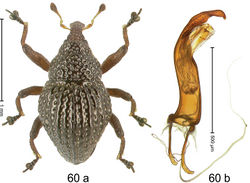Trigonopterus parvulus
| Notice: | This page is derived from the original publication listed below, whose author(s) should always be credited. Further contributors may edit and improve the content of this page and, consequently, need to be credited as well (see page history). Any assessment of factual correctness requires a careful review of the original article as well as of subsequent contributions.
If you are uncertain whether your planned contribution is correct or not, we suggest that you use the associated discussion page instead of editing the page directly. This page should be cited as follows (rationale):
Citation formats to copy and paste
BibTeX: @article{Riedel2013ZooKeys280, RIS/ Endnote: TY - JOUR Wikipedia/ Citizendium: <ref name="Riedel2013ZooKeys280">{{Citation See also the citation download page at the journal. |
Ordo: Coleoptera
Familia: Curculionidae
Genus: Trigonopterus
Name
Trigonopterus parvulus Riedel sp. n. – Wikispecies link – ZooBank link – Pensoft Profile
Diagnostic description
Holotype, male (Fig. 60a). Length 1.54 mm. Antenna, legs, and head ferruginous; pronotum, elytra, and tarsi black. Body subovate; in dorsal aspect and in profile with distinct constriction between pronotum and elytron. Rostrum punctate; epistome simple. Eyes small, anterior margin angularly projecting. Pronotum with weak subapical constriction; disk densely, coarsely punctate; each puncture with short, yellowish scale. Elytra with striae deeply impressed; each puncture with suberect, yellowish scale; intervals subglabrous, costate, partly transversely confluent. Meso- and metafemur ventrally dentate. Metafemur subapically without stridulatory patch. Onychium ca. 1.6× longer than tarsomere 3. Aedeagus (Fig. 60b) with apex asymmetrical, right side forming long curved extension; basal orifice ventrally with rim; transfer apparatus dentiform; ductus ejaculatorius without bulbus. Intraspecific variation. Length 1.46–1.54 mm. Female rostrum slightly longer, dorsally subglabrous, sparsely punctate, in basal third coarsely punctate. Female elytral apex markedly extended ventrad, beak-shaped. Abdominal ventrite 3 of females with flattened process projecting over ventrite 4, medially with bifid extension reaching base of ventrite 5, sublaterally with pair of shorter spines. Female abdominal ventrites 4–5 weakly sclerotized.
Material examined
Holotype (MZB): ARC0832 (EMBL # HE983631), WEST NEW GUINEA, Manokwari, Arfak Mts, Mokwam, Siyoubrig, S01°07.066', E133°54.710', 1870 m, 11-XII-2007, sifted. Paratypes (SMNK, ZSM): 23 exx, ARC0833 (EMBL # HE615515), ARC0834 (EMBL # HE615516), same data as holotype.
Distribution
Manokwari Reg. (Arfak Mts). Elevation: 1870 m.
Biology
Sifted from leaf litter in montane forest.
Etymology
This epithet is based on the Latin adjective parvulus (little) and refers to the species´ small body size.
Notes
Trigonopterus parvulus Riedel, sp. n. was coded as “Trigonopterus sp. 233” by Tänzler et al. (2012)[1].
Original Description
- Riedel, A; Sagata, K; Surbakti, S; Rene Tänzler, ; Michael Balke, ; 2013: One hundred and one new species of Trigonopterus weevils from New Guinea ZooKeys, 280: 1-150. doi
Other References
- ↑ Tänzler R, Sagata K, Surbakti S, Balke M, Riedel A (2012) DNA barcoding for community ecology - how to tackle a hyperdiverse, mostly undescribed Melanesian fauna. PLoS ONE 7 (1): e28832. doi: 10.1371/journal.pone.0028832
Images
|
